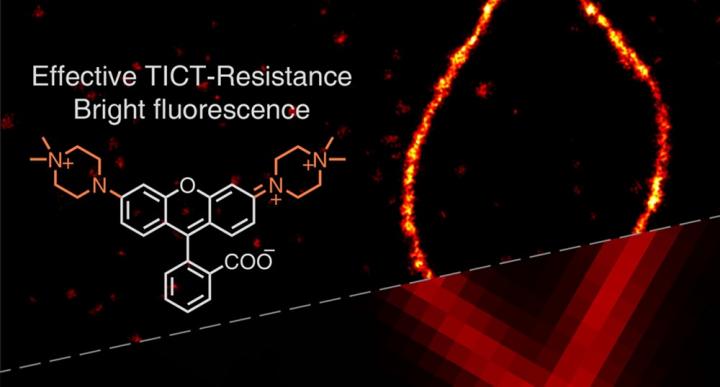Illuminating the path for super-resolution imaging with improved rhodamine dyes

Researchers from DUT and SUTD developed a new class of quaternary piperazine-substituted rhodamines with outstanding quantum yields (Φ = 0.93) and superior brightness (ε × Φ = 8.1 × 104 L·mol-1·cm-1), for imaging cell membranes and lysosomes in biological cells with super-resolution microscopy. Credit: SUTD and DUT
Recent years have witnessed a rapid evolution of advanced fluorescence imaging techniques, such as single-molecule localization microscopy (SMLM) that allows for unprecedented resolution beyond the Abbe diffraction limit of the optical microscope.
However, insufficient brightness of fluorophores has posed a major bottleneck for the further advancement of this field and caused significant constraints to in vivo cellular dynamics studies.
Owing to the widespread applications of rhodamines in many super-resolution imaging studies, significant efforts have been taken to further enhance their performances.
Researchers from Dalian University of Technology (DUT) and the Singapore University of Technology and Design (SUTD) have developed a novel strategy for chemists to achieve brighter fluorescence and clearer resolution with the use of a new class of rhodamines (see image).
This means that chemists and scientists can benefit directly from a wider colour palette that they can use during biological imaging. This will help them to distinguish various intricate cellular structures for more precise analysis that was not possible before. Their research paper has been published in ACS publications.
The researchers also successfully demonstrated that this strategy was compatible with other families of fluorophores, resulting in substantially increased fluorescence brightness and “photon budget”. The increased “photon budget” is critical to improve the resolution and clarity of super-resolution microscopes.
The key to this strategy was the combination of the mechanistic understanding of the photophysical process in these fluorophores (namely, twisted intramolecular charge transfer), and the tailed molecular design strategy to inhibit this detrimental process via an electronic inductive effect.
“With the close integration of computational and experimental studies to understand the structure-property relationships of fluorophores, the dye chemistry is currently transforming from trial-and-error to design-based molecular engineering. We expect more high-performance dyes will be created soon and thus greatly aiding the development of super-resolution microscopy,” said Assistant Professor Liu Xiaogang from SUTD.
“In addition to brightness, other characteristics such as photostability and photo-activation properties need to be optimized to meet the stringent requirements of SMLM. We look forward to working closely with computational chemists to further advance the rational design of dyes for super-resolution imaging,” added Professor Xiao Yi from DUT.
Media Contact
All latest news from the category: Physics and Astronomy
This area deals with the fundamental laws and building blocks of nature and how they interact, the properties and the behavior of matter, and research into space and time and their structures.
innovations-report provides in-depth reports and articles on subjects such as astrophysics, laser technologies, nuclear, quantum, particle and solid-state physics, nanotechnologies, planetary research and findings (Mars, Venus) and developments related to the Hubble Telescope.
Newest articles

Sea slugs inspire highly stretchable biomedical sensor
USC Viterbi School of Engineering researcher Hangbo Zhao presents findings on highly stretchable and customizable microneedles for application in fields including neuroscience, tissue engineering, and wearable bioelectronics. The revolution in…

Twisting and binding matter waves with photons in a cavity
Precisely measuring the energy states of individual atoms has been a historical challenge for physicists due to atomic recoil. When an atom interacts with a photon, the atom “recoils” in…

Nanotubes, nanoparticles, and antibodies detect tiny amounts of fentanyl
New sensor is six orders of magnitude more sensitive than the next best thing. A research team at Pitt led by Alexander Star, a chemistry professor in the Kenneth P. Dietrich…





















